#mangas rooted in japanese mythology
Text

My favorite thing about Ashiya Hanae is the inherent unsettling-ness of him that is actually not around that often.
#fukigen na mononokean#the morose mononokean#fnm#tmm#ashiya hanae#hanae ashiya#sunny arts#this is kind of my first time sharing a gif esque#or animation esque thing#i also think tumblr just shot the quality so i'm going to scream#i haven't read the manga in so long#i need to#i'm trying to draw a series of protagonists in#mangas rooted in japanese mythology#for myself you know cause i'm a nerd#next up is natsume takashi
12 notes
·
View notes
Text
I've often wondered what would happen if you used the Dragon Balls to resurrect someone that's been reincarnated?
While it has a fuckton of original fantasy elements to it, the spiritual mythology of Dragon Ball is rooted in Japanese Buddhism. Upon death, you are taken before Enma-Daio, a real mythological figure who governs the cycle of birth, death, and rebirth known as samsara.
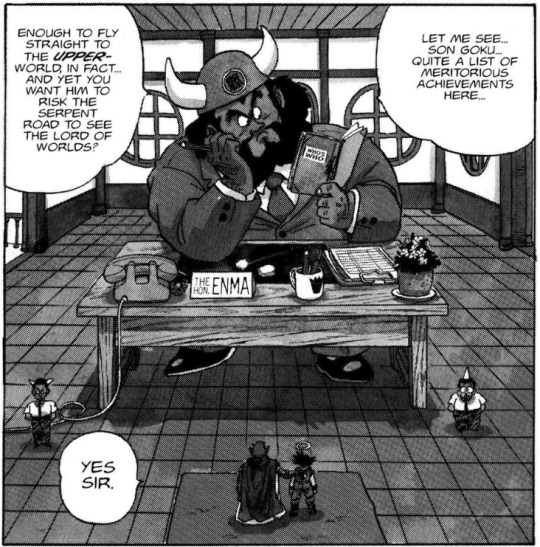
Fun fact, it's commonly believed that Goku was rewarded for his good and meritorious deeds by being allowed to keep his body and go train under Kaio. But actually, Enma-Daio was against letting Goku go to Kaio because of his good and meritorious deeds.
Enma's position was basically, "This guy's earned a full ride to The Good Place and you want to throw that away on a risky death-hike that will probably land his ass in Hell!? Are you out of your goddamn mind?"
He reluctantly acquiesced, but he wasn't happy about it.
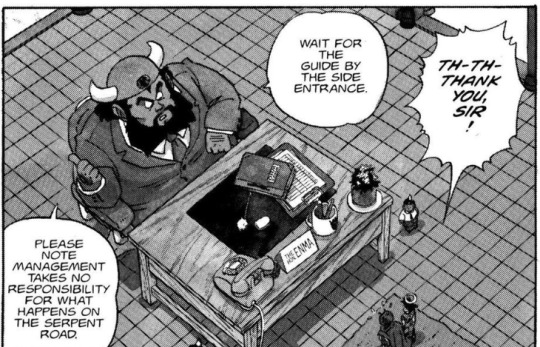
You really want to go dumbass yourself into Hell then whatever. No skin off my back, I guess.
Hell, or Jigoku as it's known in Japanese Buddhism, is a bit complicated. There are various "planes", so to speak, of Jigoku not unlike the circles of Dante's Inferno but with one particular key difference.
Under samsara, the afterlife is a transient experience. For everyone, good and bad alike, save for those who manage to break free from the karmic cycle. This is the ultimate goal.
Note that while we never see Jigoku for ourselves in the manga, it does show up in the anime - Along with two more real mythological figures.
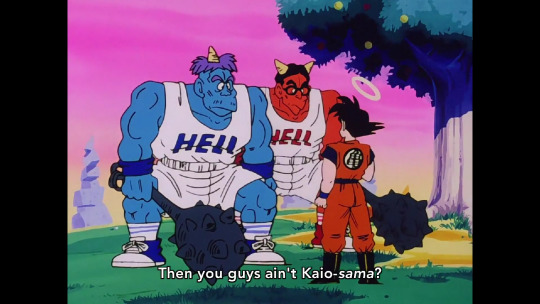
This is Gozu and Mezu, a pair of oni who serve the role of dragging people into Jigoku. Fun fact, this episode is actually based on two separate misadventures of the Monkey King Sun Wukong, who Goku is meant to be an adaptation of. Understanding the assignment, Toei drew a lot of inspiration from Journey to the West when writing Goku-centric filler episodes.
In any case, time spent in Jigoku is limited, determined by the extent of one's negative karma. There are a few references to the transient experience of being dead, predominately for villains. The most prominent is, of course, the fate of Majin Buu.
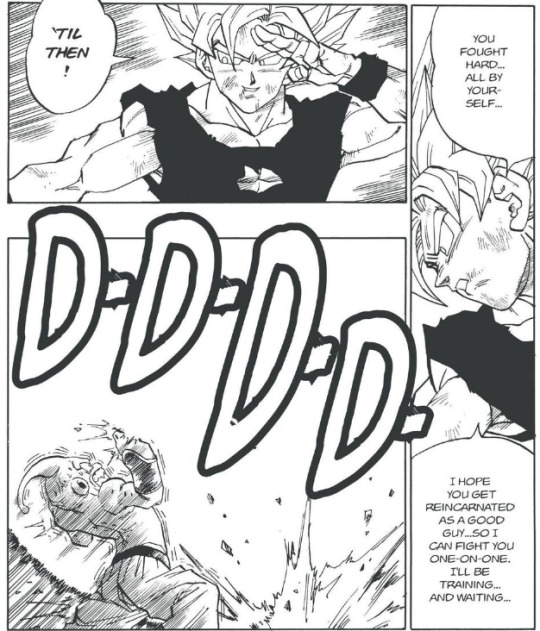
In gratitude to Goku for the great service he's performed, Enma-Daio made that happen. He rushed Buu through the cycle, allowing him to be reborn on Earth and with his power intact.
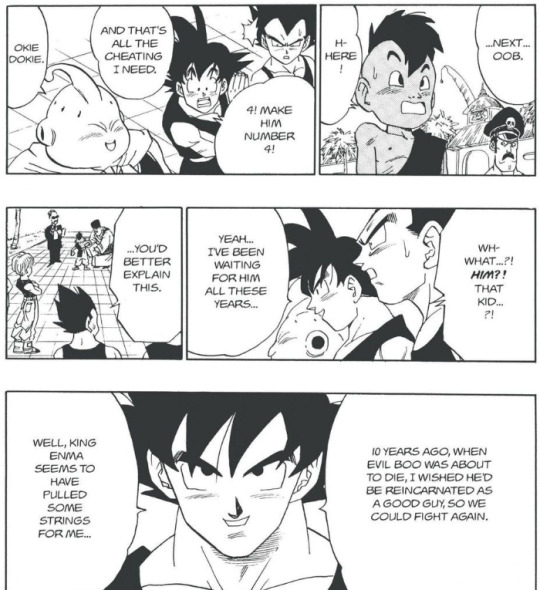
Post-God Merger Piccolo also brings up the karmic cycle when Vegeta, in a rare moment of self-reflection, seeks spiritual clarity from him.

Vegeta's going to Jigoku to expend the bad karma he's accumulated over his life, and then he too will be born again as a new incarnation.
This is the system of life and death that forms the foundation of Dragon Ball's mythology. You die, you expend the good or bad karma you've accumulated in life, and then you are reborn to go another round.
Complicating the matter is that not only does reincarnation exist within this mythology but. Uh. So does resurrection.
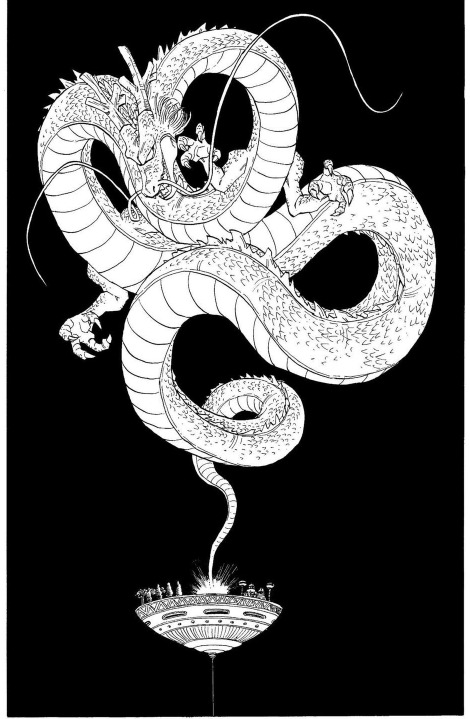
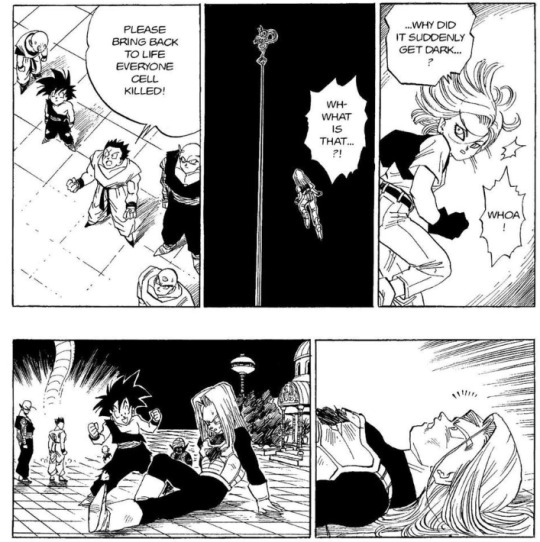
There are restrictions, of course. Shenron cannot revive someone who has already died before.
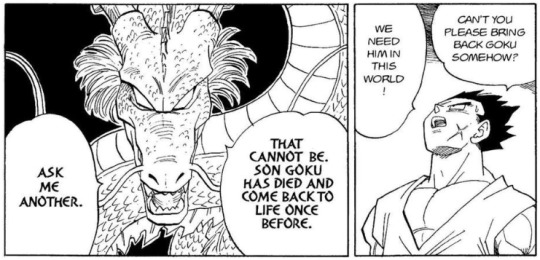
And a mass-revival under a shared condition has a time limit of one year.
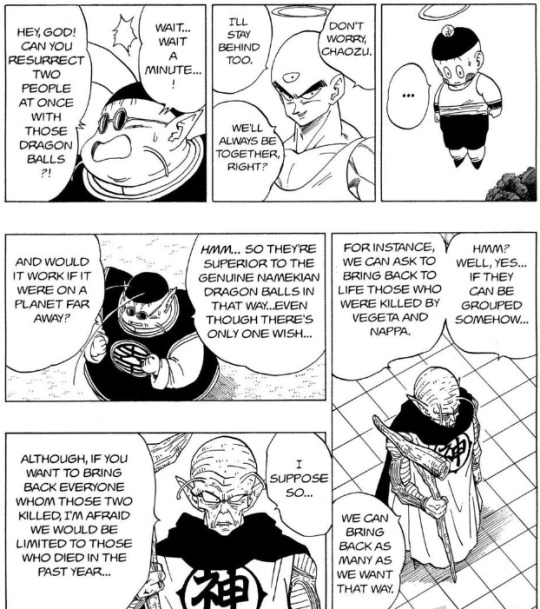
But there's no such limitation on single revivals. At least, it's never established that there is one. The time to bring it up would probably have been Goku's afterlife training for one year in preparation for the Saiyans' arrival.
So. That. Raises an interesting question.
What would happen if you had Shenron resurrect someone whose soul is presently occupying another body in the mortal world?
46 notes
·
View notes
Text
Deep dives into folklore: Japanese mythology

Japanese mythology is a rich and intricate tapestry woven over centuries, blending indigenous beliefs with influences from China, Korea, and beyond. The mythology of Japan is deeply rooted in Shinto, the native religion, as well as Buddhism and Confucianism. It comprises a diverse array of gods, spirits, mythical creatures, and epic tales. Let's delve into some key aspects of Japanese mythology:
Shinto and Kami:
Shinto: Shinto, meaning "the way of the gods," is the indigenous spirituality of Japan. It emphasizes the belief in kami, which can be translated as gods, spirits, or sacred forces. Shinto doesn't have a central religious text but is closely tied to rituals, ceremonies, and the reverence of nature.
Kami: Kami are considered divine beings or spirits that inhabit all things in nature. This includes rocks, trees, rivers, animals, and even human ancestors. Some prominent kami include Amaterasu, the sun goddess and ancestor of the imperial family, and Susanoo, the storm god.
Creation Myths:
Izanagi and Izanami: One of the most famous myths involves Izanagi and Izanami, the divine couple tasked with creating the Japanese archipelago and its many gods. Their union gave birth to several islands and deities, but tragedy struck when Izanami died while giving birth to the fire god Kagutsuchi.
Amaterasu's Hidden Sun: After a feud with her brother Susanoo, Amaterasu, the sun goddess, withdrew to a cave, plunging the world into darkness. The gods tricked her into emerging, bringing light back to the world. This myth explains the cyclical nature of day and night.
Japanese Pantheon:
Amaterasu: Often considered the most important deity, Amaterasu is the goddess of the sun, symbolizing light, fertility, and imperial power. The emperor is believed to be a direct descendant of Amaterasu.
Susanoo: The storm god, Susanoo, is associated with the sea and the destructive forces of nature. Despite his turbulent nature, he plays a crucial role in defeating the eight-headed serpent, Yamata no Orochi.
Tsukuyomi: The moon god, Tsukuyomi, is Amaterasu's brother. Unlike his stormy sibling, Tsukuyomi is associated with calmness and serenity.
Inari: A popular kami associated with rice, fertility, and prosperity. Inari is often depicted as both male and female, reflecting a duality in their nature.
Mythical Creatures:
Tengu: Human-bird hybrids known for their martial prowess and supernatural abilities. They are sometimes considered protectors of the mountains and forests.
Kappa: Water creatures resembling humanoid turtles. Kappa are mischievous but have a strong sense of politeness, and bowing to them may cause them to spill the water contained in a depression on their heads, rendering them powerless.
Yokai: A broad category of supernatural creatures, including spirits, demons, and monsters. Examples include the kitsune (fox spirits), oni (demons), and yurei (ghosts).
Influences on Art and Culture:
Japanese mythology has left an indelible mark on various aspects of Japanese culture, from traditional arts like Noh and Kabuki theater to literature, visual arts, and contemporary popular culture, as seen in anime and manga.
In summary, Japanese mythology is a captivating blend of creation stories, divine beings, and mythical creatures that provide a rich cultural and spiritual foundation for the people of Japan. It continues to inspire and shape the country's identity, connecting the past with the present.
#deep dives into folklore#folklore#deep dives#japanese mythology#mythology#japanese myths#legends#writeblr#writers of tumblr#writing#bookish#booklr#fantasy books#creative writing#book blog#ya fantasy books#ya books
37 notes
·
View notes
Text
Schoolgirls dictatorship and Naruto fandom

After a year hanging around in the tumblr Naruto fandom, I've learned with certitude that men (and women) are forbidden to have friendship and express brotherhood. But also, I've just noticed recently that poor general culture is a must. When you read a story you shouldn't be curious to google what you don't understand and expand your view. but in contrary you should tear down the plot to your limited schoolgirl comprehension of the world. And gaslight everything/everyone that/who doesn't fit to your desires. And if it's not enough, have a tantrum, call people names !
What do I mean by schoolgirl? You don't need to be at school, neither being a teenage not even being a girl. You can be a 40 years old mother of 6 with a deep schoolgirl mindset. Schoolgirl is a concept, a way of life, a philosophy of being. It's rooted from the idea that everything is about you somehow. What you feel is what the world shall feel, what you see is what the world shall see, and in the Naruto fandom what you want is what Kishimoto wanted too but couldn't say it loud enough so he needs YOU to make it more obvious to the ignorant mass of readers. Here is an exhaustive list of what a schoolgirl will demand and impose as canon no matter if it destroys the whole story in the process :
intense emotional romance (love or hate, with me or against me tropes)
intense hardcore sex (hormonal urges)
intense anxieties. Toxic love affairs, taking pleasure in the victimhood's position with a total refusal to acknowledge own mistakes is a peak.
abolition of friendship. It's a shonen but you know those sad and pathetic males in denial of their true feeling, stubbornly platonic who refuse to engage in graphic intercourses for the well-being of schoolgirls' libido.
meowmeow-fication of the world, the cuter the better. Why should we take into account the mysterious attraction in the otherness, the beauty, the paradox and awe in human's nature, human's temperaments, the subtle differences between men and women while it's so much more easy for your lazy brain when everyone is a babygirl.
Decontextualisation. War? shinobi world? history? geography? politics? nuances? foreign cultural norms? No this is too deep for a schoolgirl. You need storyline like junk food, it needs to be fat, heavily sweet and easy to digest. How dare you add subliminal references to others artists from past centuries, arts, mythologies? You mean the schoolgirl needs to actually open a non fanfictional book? Shut up !
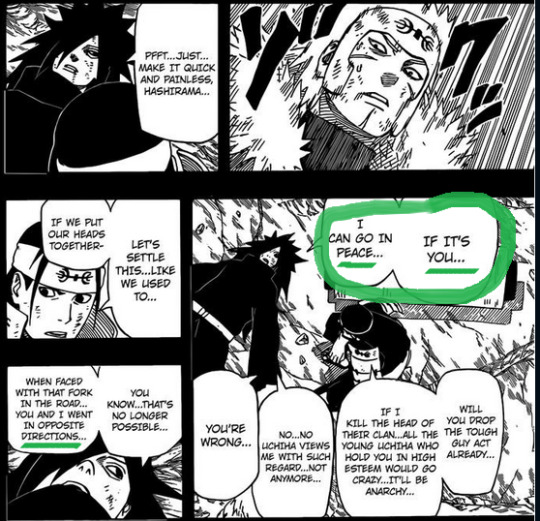
I was reading lately a comment from someone stressing that there is "obvious" romance spotted when Madara asks Hashirama to kill him and in reverse when Hashirama chose to kill himself. I thought to myself : Ok maybe not everyone knows what is the bushido (google it!) ...but surely this fandom has seen before a war movie or knighthood movie or even spend time talking with actual soldiers? They seems to genuinely ignore what is a code of honour.
Secondly we're talking about a japanese manga and the Warring state era is heavily inspired by the real Japanese warring state era (Sengoku Jidai). If you have watched the documentary Age of samurai on Netflix, they… decide to perform su*cide all the goddamn time! 😭
Often for reasons related to honour, avoidance of disgrace for the group after a general loose a battle. But also a su*cide can be a form of protestation, a way to tell an important message.

Emile Durheim (google him!), a sociologist who wrote a study about su*cide classifies them in 4 differents types : egoistic, anomic, fatalistic and altruistic su*cide. The well-known japanese seppuku performed by samurai is part of the altruistic form. When Hashirama is ready to die, It has nothing to do with emotional turmoil for the love of his life or whatever metaphysical anxiety. He wants to prove how strongly resolved he is to build his village and the new era of peace he dreamed of and for that he's resolute to give up his own life for the benefit of the group. It's true heroism and it's selfless (see, I'm not a fan of Hashirama but I can detach myself from my subjective feelings sometimes)
And just before that, Madara accepting death from Hashirama's hand (a former childhood friend) is also a proof how highly he esteems Hashirama as a victorious winner even if he is his arch-enemy. In his own way Madara shows his selflessness. In this precise moment, even in his personal pain and anger against the Senju, he's still able to recognise Hashirama's dignity and protect him from going through the same despair of losing a brother.
But yeah that's too much effort… Schoolgirl fever is way more comfortable, right?
#Schoolgirl cognitive studies phD#believe it!#Naruto fandom#Madara#Madara Uchiha#Hashirama#Hashirama Senju#Hashimada#Naruto#Naruto Shippuden
134 notes
·
View notes
Text
Dororo Review
What is ‘metal’? ‘Metal’ is a phrase I see tossed around a lot lately, though its a bit hard to define. There really is no one definition of the phrase, because its more of a feeling than a true concept. Its something that, when you see it, you know what it is. To me, ‘metal’ means fighting against unbeatable odds, triumphing over something that seems impossible, and basking in it’s glory. It’s slicing the head of a dragon, and bathing in it’s blood. ‘Metal’ is not about the result, but the fight. With this in mind, the 2019 anime series Dororo is without a doubt a perfect example of ‘metal’.
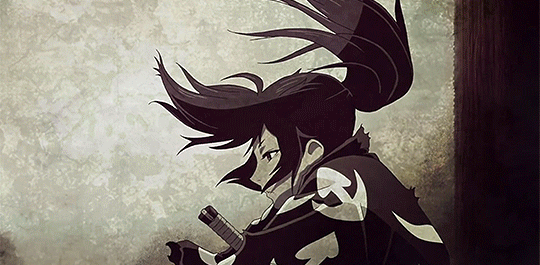
The anime follows the tale of a lord in the Muromachi period, who, to bring prosperity to his lands, makes a deal with 12 demon gods that curses his son. He is born without eyes, ears, voice, skin, and limbs, and is left floating down the river, baby Moses style. He is rescued by a woodcarver, who fits him with high-quality prosthetics, allowing him to blend in with others. He is joined by the titular character, an orphaned boy who he saves, and the two travel the land to hunt down the demon lords and get back the teen’s body parts.

Their journey is long, full of fearsome yokai that would make any monster enthusiast giddy. The designs of these monsters are rooted in Japanese mythology, yet feel fresh, like an old dog after a good haircut. They mix and match iconography, creating monsters that I’m a bit upset that I won’t be seeing them anymore, since they’re dead. A kitsune made of flame, a weasel with scythe-like claws, and a beetle that lives in a sand vortex are just a few of this series’ frightening and fascinating creatures that will stick in my mind for weeks to come.

What is most ‘metal’ in this series, though, goes beyond its gripping fight scenes and dramatic twists. Rather, it comes from it’s messaging, which clashes with its time period and the general culture of anime as a whole. Dororo is a series that explores the concepts of gender identity and disability with surprising grace and respect, something I wish a lot of other anime did.

Hyakkimaru’s story is one of struggle and identity. From the moment he is born, his body is viewed as an object of derision by his father and servants. Despite his lack of typical body part, though, he lives, by some sort of miracle. He is weak and vulnerable, but when given prosthetics by a kind and fatherly woodcarver, he is empowered, giving him the weapons he needs to slay his foes. While he cannot see in the typical sense, his view of the world allows him to detect hidden enemies that his allies are fooled by. Where other series would see a weakling who is one step away from death, Dororo shows that strength doesn’t come from your physical body, but from your fighting spirit.

Hyakkimaru is not defined by his disability, though. The series is quick to dispel that idea as well, showing his prosthetics get destroyed or lost again and again, never slowing him down. At one point in the series, little Dororo gets his arm caught in some rocks after a landslide, and Hyakkimaru quickly rushes to try and push the rocks out of the way. When his prosthetic arm cracks, he keeps pushing, until it’s completely destroyed, and even then he keeps trying. Every time he defeats a demon lord, a prosthetic part painfully rips out and is replaced with flesh, reminding us of his struggle. Hyakkimaru’s path may be accomplished through the blades on his arms, but is perfectly capable of fighting without them. Though his iconic look may come from his artificial parts, his true strength goes beyond his disability.

The most interesting part of this anime’s discussion of identity is with Dororo himself. Dororo is assigned female at birth, but for the entire series, identifies as male. The source manga treats this as a delusion, portraying Dororo as ‘confused’, and his ‘eventual’ womanhood as an inevitability. This anime, however, throws that out the window, and gives this character the proper respect he deserves, never once questioning his identity or forcing him to ‘become a woman’ in the end. Its refreshing to see an anime character who identifies as something other than what they were assigned at birth, and isn’t portrayed as incorrect for doing so. After years of transgender characters being the butt of every joke, I can smile knowing that the anime industry is starting to learn and grow in its portrayal of trans people. I can only hope that this is the start of a brighter future.

So, what is ‘metal’? Perhaps the most ‘metal’ thing of all is the struggle against the body you were given ,to fight that which society tells you is unchangeable, something as old as you yourself. This body is yours, but you are not your body, this anime proudly says. If that isn’t ‘metal’, then I don’t know what is.

60 notes
·
View notes
Note
What theme do you think the Precure franchise will try next?
Pirates (One Piece is all the rage now, and this current arc in the manga is said to be the final one, so there should be a suitable replacement once the stretchy pirate chronicles are over);
Ninjas (the public deserves an alternative option that's better than Naruto and 0% hornier than Senran Kagura);
Tarot Cards (I have a deep hatred for Daybreak Illusion, I want this theme purely out of spite);
Video Games/Technology (some of the items in PreCure range from smartphones to pads/tablets, so this should come with the territory);
Yokai Mythology (I love japanese culture, and I don't think they are properly expanded in magical girl media as they should);
Plushies/Toys (I initially assumed that H*gtto would have this theme, but it didn't, so I demand that);
Lolita Fashion (the history of Lolita Fashion has its roots in social feminine rebellion, and there's plenty of subcultures that can be translated into Cures);
Journey to the West (because if Shounen can reference Sun Wukong over and over, then Magical Girls should do the same!)
And these are the ones that quickly popped into my mind.
I used to want Police Officers and Genies as future themes back then; but they were quickly dropped, because of the controversies they tend to carry... if you know, you know.
10 notes
·
View notes
Note
do you know Jujutsu Kaisen? In that series theres a character that summons a shikigami called Makora (thats what he pronounces in the anime) but the subs and dubs changed it to Mahoraga.
Any idea what the hell happened here?
I never did get caught up on JJK, although I always meant to. People have pointed out that it has some fun buddhist theming in it, which of course I'm always interested in. So while I don't know the specifics of how the name is used in the series, I can actually see what the basic problem is here.
The name/term Makora[魔虚羅] was shortened from Makoraga[摩睺羅伽] which is localized from the Chinese móhoúluójiā[摩睺羅伽]which is itself the Chinese localization of the sanskrit Mahoraga[महोरग]; a sort of race of mythical beings in Buddhism, carried over from its roots in Hindu mythology. So it's not like the word has a strict "meaning" outside of being the name of the specific mythological being, which you could definitely leave as Makora, but they seem to have chosen to "translate" the Japanese word back to the Indian one it originally came from.
It's kind of like if they had translated Ashisogi-Jizo as Ashisogi-Kshitigarbha, or Kokujo Tengen Myouou as Kalasutra Tengen Vidyaraja. Definitely a little clunky and weird, and not especially functional in actually conveying meaning, but not necessarily "wrong" in the strictest sense. But for me, since I lack the context, it raises questions as to whether its specific usage in the manga is referring to specifically the Japanese iteration of said religious figures, or actually drawing on the original cultural context with all the tonal and stylistic implications of foreign and ancient almost primordial implications that come with that.
#jujutsu kaisen#jjk meta#i feel weird using that tag when i only ever got a like a volume into the series...#but I'll hope any fans that stumble into this post#can appreciate that I'm coming at this with a substantial handicap
4 notes
·
View notes
Text
🌸 Things of AOT impressed me 🌸
1. All the birthdays of the main characters are connected to different dates of cultural importance, like, for example, Levi's birthday, which is December 25, Christmas day. But in Marco's case, he hides a dark secret, his birthday is June 16, which happens to be exactly the middle of the year, which hints at the character's own death.
2. In addition to a theme park, they also brought out other products, such as perfumes of each character, Levi, has a fresh scent that reminds of soap, Armin's has a pure vanilla scent and Hange's smells like a mysterious and bitter herb.
3. The story of the titans has its roots in Norse mythology, in the Viking tradition there were several separate kingdoms as well as the walls, as history progresses the gods built a wall against the giants and when Ragnarok happens, the giants break down the wall and kill the gods, which is what happens at the beginning of the anime.
4. Levi's name is of Hebrew origin and means "union" and the surname derives from the German name "Ackermann" which means country man.
5. Mikasa's red scarf may be a reference to the red thread of fate, which in Japanese folklore represents an unbreakable connection between soulmates or lovers.
6. Speaking of the scarf, in the manga it was initially black.
7. Levi seems to have a fondness for black tea and it has been confirmed that Levi would have liked to open his own tea shop.
8. Levi sleeps an average of 2 to 3 hours a day and usually does so in a chair, even the author states that if he had to say something to Levi it would be: "Go to sleep now!"
9. Speaking of sleep, Annie, she has a habit of talking in her sleep, sometimes muttering the sound “wush”, specifically when she dreams of practicing kicking trees.
9. Both Levi and Hange, if they had to be of a real nationality, they would be French.
10. Gabi's physique comes from a sketch Isayama made of a female version of Eren.
11. In a question and answer session, he was asked about Levi's preferred type of woman, to which he replied that probably since he is short, he likes tall people.
12. All the titans that form the walls measure exactly 50 meters.
13. To design Annie's updo, Isayama was influenced by a photo of Avril Lavigne.
#aot#snk#attack on titan#shingeki no kyojin#snk levi#armin arlert#eren jeager#erwin smith#mikasa ackerman#snk eren#annie#hange
64 notes
·
View notes
Note
Hello! I would love to hear your take on a theory I’ve heard, maybe you’ve already done something about it but —
The theory that the phantomhives are actually of Irish/Scottish/Celtic decent and that’s part of the reason Victoria (supposedly) wiped them out. Also kind of explains the “Windsor incident” and the “sour faces” of relatives at the mention of the twins names (I realize Ciel is French—I believe? But still!)
I just wanna sing ancient Celtic tunes to OCiel 😭 hits home for me because my lineage is extremely Irish and German, and I know how horribly they treated anyone Irish or Scottish at that time, even in America. So sad to think this might be the case, albeit with a supernatural twist
Celtic roots?
There has been discussion of that possibility within the fandom, and I've had a few posts and reblogs that talk about it.
For one thing, some in the fandom think our earl (who only pretends to be Ciel) might have named Finny after himself. A specific book has been shown on two separate occasions in the manga: Fenian Cycle: Celtic Mythology.
In ch100, it's shown several times, as our earl explains to Finny why he's chosen that name for him.

And it's shown again on the cover of ch132.
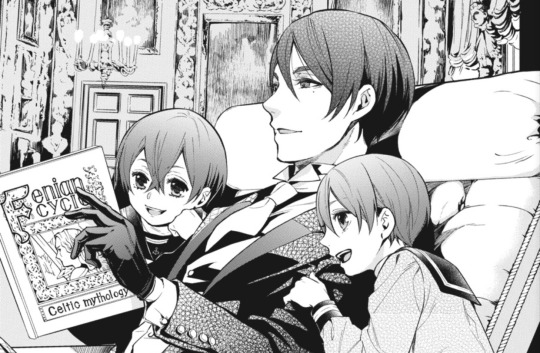
Now, our earl selects the name for Finny because of his blond hair and his strength. And years later, when our earl joins the circus, he calls himself Finnian. Some people think this is a clue that it's his real given name, and perhaps he has never liked it because it doesn't fit: he doesn't have blond hair, and he's not all that physically fast, strong, or healthy. Canonically, Rachel is the one to name the boys, and I personally cannot see her choosing a name like that for our earl. He didn't show signs of asthma until he was 5 or so, but he obviously doesn't have blond hair, and I expect Rachel to choose a more fitting name for him. Preferably one that works well with "Ciel" (like Claus and Lucas, mirror twin brothers in Mother3, having anagram names). That's one of the reasons why I like the name Elic. (I also like that it means "protection", much like Alex.) However, the idea that our earl is really Finnian (or some spelling variant) persists within the fandom.
I think it's more likely that our earl just fondly remembers Vincent reading the book to him, but it's interesting that the book is shown again on a cover page, with Vincent reading to the boys, and the tag line is "Gazing at the promised future". The chapter includes Vincent showing the boys around the estate and their earldom, but that cover also happens to show the boys "gazing" at the book. This could be a hint that the family is indeed of Celtic origins, or at least partly, despite the fact the image looks more like "gazing at the fabled past".
Then Yana-san revealed the cover art for Artworks 3, and wow. That's a lot of tartans and thistles. She mixes so many different tartan patterns that we cannot really say the family must be from one particular clan or another. But it's really interesting for her to choose all these tartans and pair them with a bunch of thistle, Scotland's national flower. There are even thistles on his boots.


Here and here are a couple old posts about it, including the symbolic meaning of thistles (includes some Japanese flower language meanings, too). Notice thistles are often associated with "protection". (Makes me like the name Elic even more.)
If the twins have some Celtic roots, it might not actually be on the Phantomhive side so much as Rachel's side. Her sister and father have that red hair, after all, and so-called "Gingers" have suffered discrimination for a very long time, particularly in England. Vincent might have wanted to teach his boys to appreciate and take pride in their partly Celtic heritage.
If Rachel has a strong Celtic background, then Vincent's choice to marry her might have ruffled some feathers. Perhaps family and people in the peerage didn't think it was a good idea; maybe this made Queen Victoria angry. Keeping all this in mind (and making a point of it), the decidedly strong-willed Rachel might have selected names that reflect each side of the family. Something French for the firstborn... and something Celtic for the unexpected twin? (Idk exactly where Elic comes from, but it looks/sounds Celtic, doesn't it? Oh, hey. Look. CELTIC. 😆)
Every time I look up "Elic name meaning" online, I get different results for both the meaning and origin, but when I looked a moment ago, this was from one of the top websites (Names.com):

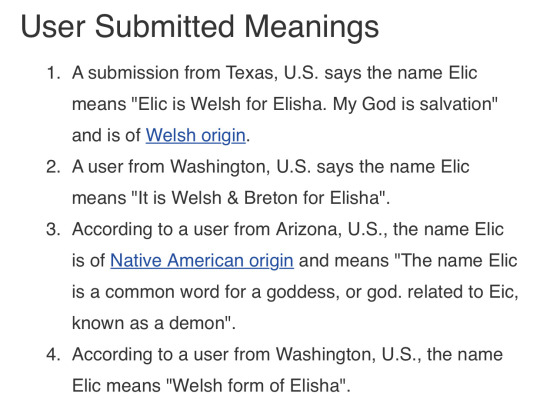
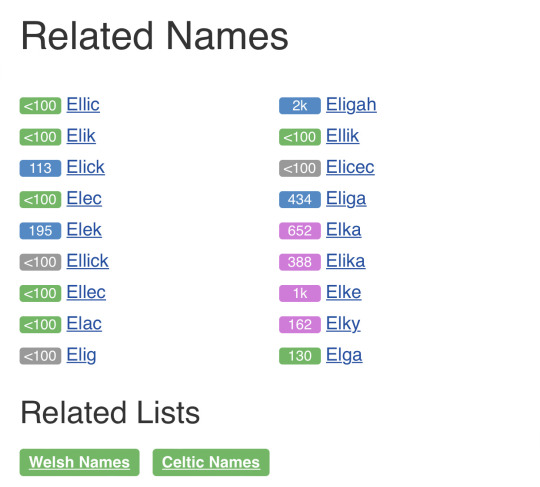
Another website says it's Greek in origin and means "defender of mankind", a variation of Alec. Older website entries used to give a similar meaning (protection/protector of man) but claim it's Hungarian or something. So, nothing conclusive, of course, but gosh I hope our earl ends up being Elic. I really do. It's one of the major Mother3 predictions, so of course I'm fond of it. 😅
Speaking of lineage, mine is English, German, Irish, Scottish, French, and Dutch. My first name, Arran, is after the Isle of Arran (Scottish). My last name, Walker, is supposedly from the MacGregor clan, while my Allison ancestors (married into the Walkers about six generations ago) came from the MacAlister clan, straight from Somerled himself! Then again, being a descendent of Somerled is somewhat common. Roughly 500,000 people today are. Only Genghis Khan is documented as having more -- about 16 million. Big oof 😅.
BONUS:
Another person to mix with the Phantomhives could prove to be of Celtic decent.
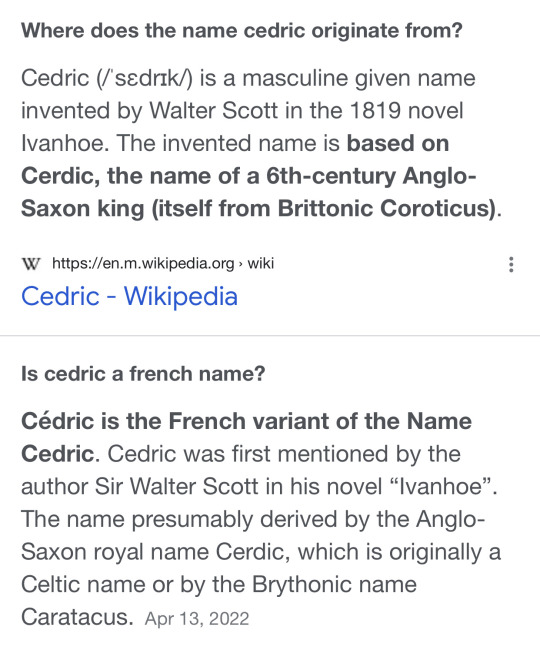
#black butler#kuroshitsuji#celtic#phantomhive family#rachel phantomhive#vincent phantomhive#our earl#real ciel#earl phantomhive#ciel phantomhive#real name#finny#finnian#elic#name meanings#mother3 predictions#mother3#fenian cycle#celtic mythology#artworks 3#tartan#thistle#name origins#lineage#tehgreatboo#asks#i answer#answered asks#may 20 2022#long post
77 notes
·
View notes
Text

𝐍𝐀𝐌𝐄 : circe [ name meaning bird ; in mythology she is a magic goddess. ]
𝐓𝐈𝐓𝐋𝐄 : priestess / sage, dragon knight
𝐀𝐆𝐄 : 20-27
𝐆𝐄𝐍𝐃𝐄𝐑 : female
𝐇𝐎𝐌𝐄 : atlantis [10,000BCE]
𝐄𝐓𝐇𝐍𝐈𝐂𝐈𝐓𝐘 : greek, atlantean
𝐀𝐏𝐏𝐄𝐀𝐑𝐀𝐍𝐂𝐄 : the "original" manifestation of the dark magician girl.

𝐍𝐀𝐌𝐄 : mana [ name meaning everlasting ; persian roots]
𝐓𝐈𝐓𝐋𝐄 : apprentice [formerly], high priestess [currently]
𝐀𝐆𝐄 : 15 [apprentice], 20+ [high priestess]
𝐆𝐄𝐍𝐃𝐄𝐑 : female
𝐇𝐎𝐌𝐄 : new kingdom of ancient egypt [ approx 1000BCE]
𝐄𝐓𝐇𝐍𝐈𝐂𝐈𝐓𝐘 : half-egyptian, half- greek
𝐀𝐏𝐏𝐄𝐀𝐑𝐀𝐍𝐂𝐄 : follows the manga concept of mana having dark skin but blonde hair, as an adult she carries the physical features of magi magi magician gal, with ankh tattooed in between her chest.

𝐍𝐀𝐌𝐄 : mana [ name meaning everlasting ; persian roots]
𝐓𝐈𝐓𝐋𝐄 : dark magician girl / magi magi magician gal
𝐀𝐆𝐄 : 3000+
𝐆𝐄𝐍𝐃𝐄𝐑 : female
𝐇𝐎𝐌𝐄 : dominion of the beast [ current timeline ]
𝐄𝐓𝐇𝐍𝐈𝐂𝐈𝐓𝐘 : half-egyptian, half- greek ; spirit / eidolon
𝐀𝐏𝐏𝐄𝐀𝐑𝐀𝐍𝐂𝐄 : by default she takes on the dark magician girl's bubbly appearance, but magi magi is just as much her original form as the DMG. she has completely merged with her ka, as seen in the DOMA arc.

𝐍𝐀𝐌𝐄 : mana [ name meaning love ; affection, japanese roots]
𝐓𝐈𝐓𝐋𝐄 : none / university student
𝐀𝐆𝐄 : 18+
𝐆𝐄𝐍𝐃𝐄𝐑 : female
𝐇𝐎𝐌𝐄 : domino city, japan [current] ; london, england [ previous ]
𝐄𝐓𝐇𝐍𝐈𝐂𝐈𝐓𝐘 : mostly japanese, has some european in her blood
𝐀𝐏𝐏𝐄𝐀𝐑𝐀𝐍𝐂𝐄 : very similar to her previous soul spirit appearance, she takes after her strong european roots of having natural blonde hair / aquatic eyes, but overall she is still very much japanese given her petite physique and pearly complexion.
7 notes
·
View notes
Photo


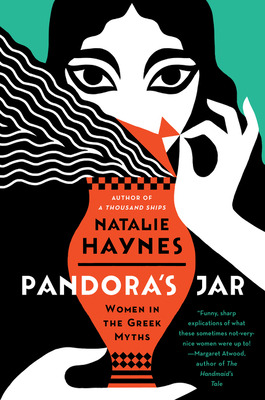

Mythology Picks to Check Out
Legendary Ladies: 50 Goddesses to Empower and Inspire You by Ann Shen
From the beloved author and artist behind Bad Girls Throughout History comes this lushly illustrated book of goddesses from around the world. Aphrodite, the Greek goddess whose love overcame mortality. Mazu, the Chinese deity who safely guides travelers home. Lakshmi, the Hindu provider of fortune and prosperity. These powerful deities and many more are celebrated in gorgeous artwork and enlightening essays that explore the feminine divine and encourage readers to empower themselves. Ann Shen's signature watercolors make Legendary Ladies a unique, gift-worthy homage to the mighty women within.
Mythology: Timeless Tales of Gods and Heroes by Edith Hamilton
Since its original publication by Little, Brown and Company in 1942, Edith Hamilton's Mythology has sold millions of copies throughout the world and established itself as a perennial bestseller.
For more than seven decades readers have chosen this book above all others to discover the enchanting world of mythology -- from Odysseus's adventure-filled journey to the Norse god Odin's effort to postpone the final day of doom. This deluxe, hardcover edition is fully-illustrated throughout with all-new, specially commissioned art, making it a true collector's item.
Pandora's Jar: Women in the Greek Myths by Natalie Haynes
The tellers of Greek myths--historically men--have routinely sidelined the female characters. When they do take a larger role, women are often portrayed as monstrous, vengeful or just plain evil--like Pandora, the woman of eternal scorn and damnation whose curiosity is tasked with causing all the world's suffering and wickedness when she opened that forbidden box. But, as Natalie Haynes reveals, in ancient Greek myths there was no box. It was a jar . . . which is far more likely to tip over.
In Pandora's Jar, the broadcaster, writer, stand-up comedian, and passionate classicist turns the tables, putting the women of the Greek myths on an equal footing with the men. With wit, humor, and savvy, Haynes revolutionizes our understanding of epic poems, stories, and plays, resurrecting them from a woman's perspective and tracing the origins of their mythic female characters.
The Book of Yokai: Mysterious Creatures of Japanese Folklore by Michael Dylan Foster, Shinonome Kijin (Illustrator)
Monsters, ghosts, fantastic beings, and supernatural phenomena of all sorts haunt the folklore and popular culture of Japan. Broadly labeled yokai, these creatures come in infinite shapes and sizes, from tengu mountain goblins and kappa water spirits to shape-shifting foxes and long-tongued ceiling-lickers. Currently popular in anime, manga, film, and computer games, many yokai originated in local legends, folktales, and regional ghost stories.
Drawing on years of research in Japan, Michael Dylan Foster unpacks the history and cultural context of yokai, tracing their roots, interpreting their meanings, and introducing people who have hunted them through the ages. In this delightful and accessible narrative, readers will explore the roles played by these mysterious beings within Japanese culture and will also learn of their abundance and variety through detailed entries, some with original illustrations, on more than fifty individual creatures. The Book of Yokai provides a lively excursion into Japanese folklore and its ever-expanding influence on global popular culture. It also invites readers to examine how people create, transmit, and collect folklore, and how they make sense of the mysteries in the world around them. By exploring yokai as a concept, we can better understand broader processes of tradition, innovation, storytelling, and individual and communal creativity.
#mythology#nonfiction#non fiction#history#booklr#book blog#booktok#reading recommendations#Book Recommendations#library books
8 notes
·
View notes
Note
Do you mind if I ask your top 10 favorite characters (can be male or female) from all of the media that you loved (can be anime/manga, books, movies or tv series)? And why do you love them? Sorry if you've answered this question before.....Thanks....
Hi!
Actually, no one has asked me this before. My blog really hasn’t been popular (receiving a lot of notes) until I began posting about Buddy Daddies and Wayne Family Adventures recently. I would be happy to give you my list. I am new to anime/manga, so I may misspell some of the Japanese names or put them in the wrong order. I apologize in advance. My list changes based on my mood and current stage in life. These are my top 10 right now.
1. Yor Forger (Spy x Family) - As an asexual person, I relate to Yor being judged by her coworkers for still being single at 27. I’m 26, so that part punched me in the gut when I first watched the anime. Also, Yor is a total badass as an assassin, is a lightweight when drinking (like me), and is the kindest person you’d ever meet. She’s an all-around great character.
2. Yelena Belova (MCU) - I am specifically talking about the MCU version of Yelena. She is also a badass, has a strong relationship with her sister, and is funny. I can’t wait to see her in Thunderbolts next year and hope the MCU makes her canonically asexual. We need the rep.
3. Tori Spring (Solitaire/Heartstopper) - Tori is canonically asexual and is so relatable in Solitaire. I’ve been through a time where I felt depressed, and Tori spoke my thoughts of being tired of everyone and everything and not understanding people being in relationships. I know that says a lot about my mental health, but yeah.
4. Hatsuharu Sohma (Fruits Basket) - Haru is the best character from Fruits Basket. He is loving, protective, and hilarious. I love how he is always looking out for his cousins, and I would love to have someone like him in my life.
5. Seishuu Handa (Barakamon) - I live in the country and greatly enjoy how Handa navigates country life and developing a deeply-rooted community in the village without developing a romantic relationship. I also love how he immediately accepted his role as big brother to Naru and Hina.
6. Kazuki Kurusu (Buddy Daddies) - This man has a huge heart and deserves the world. He loves his found family and is also the responsible one cooking and cleaning for them. Also relatable.
7. Elizabeth Bennet (Pride and Prejudice) - I love me some Jane Austen, and Elizabeth is the best heroine from her books. The 2005 movie is my comfort movie.
8. Jude Duarte (The Folk of the Air series) - Badass human making her way to the top in the land of fairies. We stan the queen. I also relate to her by being an identical twin too.
9. Hestia (Greek Mythology) - I hope myths count. Hestia is the kindest goddess to everyone, even humans. Her presence is so refreshing in myths after reading about what the other gods and heroes have done…
10. Hitohito Tadano (Komi Can’t Communicate) - I’m watching this anime now and love how sweet Tadano is. He is so attentive, not only to Komi, but to all of his classmates. I love that.
2 notes
·
View notes
Text
Exploring the Enchantment of Anime: Unveiling its Cultural Significance
Anime, a vibrant and diverse form of animation originating from Japan, has captivated audiences worldwide for decades. With its unique art styles, compelling narratives, and rich cultural influences, anime has transcended geographical boundaries to become a global phenomenon. In this article, we delve into the enchanting world of anime, exploring its cultural significance, evolution, and enduring appeal.
Unraveling the Origins: A Brief History of Anime
Anime traces its roots back to early 20th-century Japan, where it emerged as a distinct art form inspired by Western animation techniques. Influenced by manga (Japanese comics), traditional Japanese art, and global animation trends, anime gradually evolved into a dynamic medium with its own identity. The post-World War II era witnessed the rise of iconic anime pioneers such as Osamu Tezuka, whose works laid the foundation for modern anime storytelling.
Artistry in Motion: The Unique Aesthetics of Anime
One of anime's most striking features is its diverse range of artistic styles, from the bold lines and exaggerated expressions of shonen (young male) anime to the intricate details and ethereal beauty of shojo (young female) anime. Each genre and subgenre of anime boasts its own visual language, allowing creators to convey emotions, themes, and atmospheres with remarkable depth and nuance. The fluidity of animation in anime, coupled with stunning backgrounds and character designs, elevates storytelling to new heights of cinematic splendor anime.
Beyond Entertainment: Anime as Cultural Reflection
Anime serves as more than mere entertainment; it is a reflection of Japanese culture, society, and values. Themes such as honor, friendship, perseverance, and self-discovery resonate deeply with audiences around the world, transcending cultural barriers. Moreover, anime often incorporates elements of Japanese folklore, mythology, and history, offering viewers glimpses into the country's rich heritage. From the futuristic landscapes of cyberpunk anime to the historical epics of samurai dramas, anime provides a window into Japan's past, present, and future.
Global Influence: The Spread of Anime Across Borders
In recent decades, anime has experienced unprecedented global popularity, thanks in part to digital streaming platforms and online communities. Iconic series such as "Naruto," "Dragon Ball," and "Attack on Titan" have amassed loyal fan bases worldwide, sparking cosplay events, conventions, and fan art movements. The accessibility of subtitles and dubbing has made anime accessible to non-Japanese audiences, fostering a vibrant international fandom that transcends linguistic and cultural boundaries. Anime's influence extends beyond entertainment, shaping fashion trends, inspiring artistic expression, and even influencing global pop culture.
Anime in the Digital Age: Innovation and Evolution
The advent of digital technology has revolutionized the anime industry, enabling creators to produce visually stunning animation and reach wider audiences through online platforms. From 3D animation techniques to computer-generated imagery (CGI), anime continues to evolve and experiment with new technologies while staying true to its artistic roots. Moreover, streaming services and crowdfunding platforms have empowered independent animators to produce original content and connect directly with fans, bypassing traditional production channels.
Challenges and Controversies: Navigating Cultural Sensitivities
Despite its widespread acclaim, anime has faced criticism and controversy over its portrayal of certain themes, characters, and cultural stereotypes. Issues such as cultural appropriation, sexualization of characters, and depictions of violence have sparked debates within both the anime community and broader society. As anime continues to gain prominence on the global stage, creators and audiences alike grapple with the responsibility of representing diverse perspectives with sensitivity and respect.
Looking Ahead: The Future of Anime
As we look to the future, anime remains a dynamic and ever-evolving medium that continues to push boundaries and defy expectations. With advancements in technology, changing audience preferences, and a growing demand for diverse representation, anime is poised to enter new frontiers of creativity and innovation. Whether through traditional hand-drawn animation or cutting-edge digital techniques, anime will continue to inspire and enchant audiences for generations to come.
Conclusion: Celebrating the Enduring Magic of Anime
In conclusion, anime stands as a testament to the power of storytelling, artistry, and cultural exchange. Its ability to captivate audiences, transcend borders, and reflect the human experience underscores its enduring relevance in an ever-changing world. As we celebrate the diversity and creativity of anime, let us embrace its magic and continue to explore the boundless possibilities of this extraordinary medium.
1 note
·
View note
Text
The Elder Sister-Like One Manga

"The Elder Sister-Like One" is a dark fantasy anime series that delves into the mystical realms of Japanese folklore. The story follows the life of Yori, a withdrawn teenager who tragically lost his parents and has been left to fend for himself in an oppressive reality.
Desperate and on the brink of despair, Yori inadvertently summons an otherworldly demon named Jashin-chan. But contrary to his expectations, Jashin-chan possesses a gentle demeanor reminiscent of an elder sister figure. Despite her demonic origins and terrifying appearance, she eagerly takes up the role as Yori's protector and caretaker.
Together, Yori and Jashin-chan navigate through a world teeming with supernatural entities, unraveling twisted tales rooted in ancient mythology. As they encounter malevolent spirits and dark forces lurking in the shadows, they must rely on their blossoming bond to overcome sinister adversaries threatening their fragile existence.
"The Elder Sister-Like One" grapples with themes of loss, redemption, friendship, and finding one's place amidst adversity. Through its stunning animation style and gripping storytelling, this series explores the complexities of human emotions while immersing viewers in a captivating supernatural narrative where unexpected kinship triumphs over darkness.
Join us in supporting the talented manga author of 'The Elder Sister-Like One Manga' by purchasing a copy today at gekimanga.com! Immerse yourself in the captivating storyline and breathtaking illustrations of this incredible series. By buying the manga, not only will you enjoy hours of entertainment, but you'll also contribute to the success and recognition of the author's hard work. Don't miss out on this opportunity to support their creativity and passion. Get your copy now at gekimanga.com!
0 notes
Text
Pulau Misterius" (Mysterious Island)
Manga, an original and legendary form of storytelling that begun in China, has gained spirits worldwide. Its universal charm has transcended their indigenous borders, influencing musicians and builders from various parts of the globe. One particular nation moved by that trend of Manga is Indonesia.
Indonesia, an archipelago abundant with tradition, folklore, and convention, has a vibrant creative community. With the rise in the reputation of Manga, it absolutely was inevitable that the country's musicians would find a confluence between their traditions and that modern artwork form. That synthesis has birthed what we may term as "Indonesian Manga" ;.
Special Identity
While heavily affected by Western Manga, Indonesian Manga isn't only an imitation. It provides their distinct quality, deriving essence from Indonesia's large lore of myths, stories, and tales. Experiences could be occur the history of Bali's picturesque landscapes, the busy streets of Jakarta, or the serene temples of Yogyakarta. These local nuances give the art variety an original touch. mangayaro
Popular Styles
Indonesian Manga frequently explores styles like spiritualism, the conflict of modernity and custom, and the profound connect between people and nature, which will be deep-rooted in Indonesian culture. Regional mythological creatures, reports of ancestral spirits, and traditional dances and ceremonies often function prominently, providing viewers a view in to the wealthy tapestry of Indonesian culture.
A Growing Market
The Indonesian Manga market, though nascent, is on a development trajectory. Regional amusing conventions, workshops, and devoted Manga classes in art schools testify to its escalating popularity. Writers will also be knowing that tendency, supporting regional artists and bringing their operates to the fore.
Challenges and the Way Forward
However, like any rising market, the Indonesian Manga world people challenges. The dominance of Western Manga in the world wide market can sometimes overshadow local creations. There's also a significance of better quality systems to display Indonesian Manga to the world. But with the digital innovation and platforms like webcomics, musicians now have an unprecedented possibility to achieve an international audience.
Conclusion
The blend of Japanese Manga aesthetics with Indonesia's rich cultural backdrop supplies a special and refreshing accept the art form. Indonesian Manga has got the potential not just to entertain but and also to educate visitors concerning the nation's traditions, folklore, and way of life. As the world becomes more interconnected, the appetite for varied stories grows. It is going to be not surprising if, in the coming years, Indonesian Manga carves a distinct segment for it self, captivating readers globally.
0 notes
Text
Minor science fiction subgenres:
Alien Conspiracy Science Fiction: The basic premise of Alien Conspiracy Sci-Fi is that the existence of extraterrestrial life or humanity's interactions with extraterrestrial life has been covered-up.
Astrobiology: Astrobiology is the study of life in the universe, here on Earth and out among the stars.
Classics: The pillars of the science fiction genre
Cybernetic Revolt: The cybernetic revolt, the robot uprising, the destruction (or attempted destruction) of humanity by artificial intelligence. Artificial intelligence may be robots, a supercomputer, a computer network, or a whole race of intelligent machines.
ESP Science Fiction: ESP Science Fiction features characters with Extra-Sensory Perception (ESP). The core ESP powers are clairvoyance, telepathy, and precognition. Under a broader definition of ESP, other powers are included: Telempathy (or empathy), Telekinesis, Teleportation, Levitation, Healing, Pyrokinesis, Coercion,...
Galactic Empire: In this subgenre, there is an empire that spans galaxies.
Isekai: Isekai is a Japanese genre of light novels, manga, anime and video games that revolve around a person who is transported to and has to survive in another world, such as a fantasy world, virtual world, planet or parallel universe.
Mecha: The term mecha may refer to both scientific ideas and science-fiction genres that center on giant robots or machines (mechs) controlled by people. Mechas are typically depicted as humanoid mobile robots.
Mythological Science Fiction: Stories within this sub-genre are rooted in, or draw from fables, mythology, folklore, or fairy tales. The story may retell the myth entirely or draw from the tropes, themes, and symbolism of the myth.
Planetary Romance: Planetary romance is a subgenre of science fiction in which the bulk of the action consists of adventures on one or more exotic alien planets, characterized by distinctive physical and cultural backgrounds.
Recursive Science Fiction: Recursive Science Fiction is the most metafictional of all Science Fiction sub-genres; it is Science Fiction about Science Fiction. That is to say, the narrative story of a Sci-Fi story explores Sci-Fi itself. Plots, characters, settings, descriptive terms (like avatars) are recycled throughout Sci-Fi. There are three basic variants of Recursive Sci-Fi: tuckerization, intertextuality, full-blown recursion. Tuckerization uses real people as fictional characters usually achieved through inside-knowledge, much like an inside joke or homage. These characters can also be Sci-Fi fans or authors. Intertextuality happens when a reference to another text is made within the story. Intertextuality is more than just the influence of one text on another, there are deliberate connections that shape the narrative. Full-blown recursions are self-reflexive narratives that offer commentary on the genre of Sci-Fi.
Restored Eden: Taking place on Earth in a near or far future, Restored Eden Science Fiction depicts an Earth where most of humanity has moved on and the Earth has healed to become a paradise.
Retro Futurism: Retro Futurism is a trend in the arts that prizes futuristic visions from the past (until about 1960). Futurism was a reaction to a surge in technological progress and featured visions of a utopia just around the corner and a sense of optimism. The return to this historical futurism allows us to reexamine the imagination and dreams of the past.
Slipstream: A subgenre with elements of the surreal and postmodern themes. It crosses the genres of literary fiction and speculative fiction, including science-fiction, fantasy or both. Slipstream is often defined as fantastical, illogical, surreal, and jarring.
Subterranean fiction: Subterranean fiction is a subgenre of adventure fiction, science fiction, or fantasy which focuses on fictional underground settings, sometimes at the center of the Earth or otherwise deep below the surface.
Superhero fiction: Superhero fiction is a genre of speculative fiction examining the adventures, personalities, and ethics of costumed crime fighters known as superheroes, who often possess superhuman powers and battle similarly powered criminals known as supervillains. The genre primarily falls between hard fantasy and soft science fiction spectrum of scientific realism.
Sword and Planet: Sword and Planet Science Fiction merges the medieval with the cosmos.
Transhumanism: The stories offer possibilities about how humans may transform in the future. These transformations may be small or complete alterations. These transformations are often characterized as evolution, often with the aid of science—as in biological uplift.
Undersea Science Fiction: Space offers infinite possibilities for our imaginations, but so too does the ocean. A self-describing sub-genre, Undersea Science Fiction takes place under the sea.
Xenofiction: It is a term applied to stories told from the perspective of a non-human.
0 notes